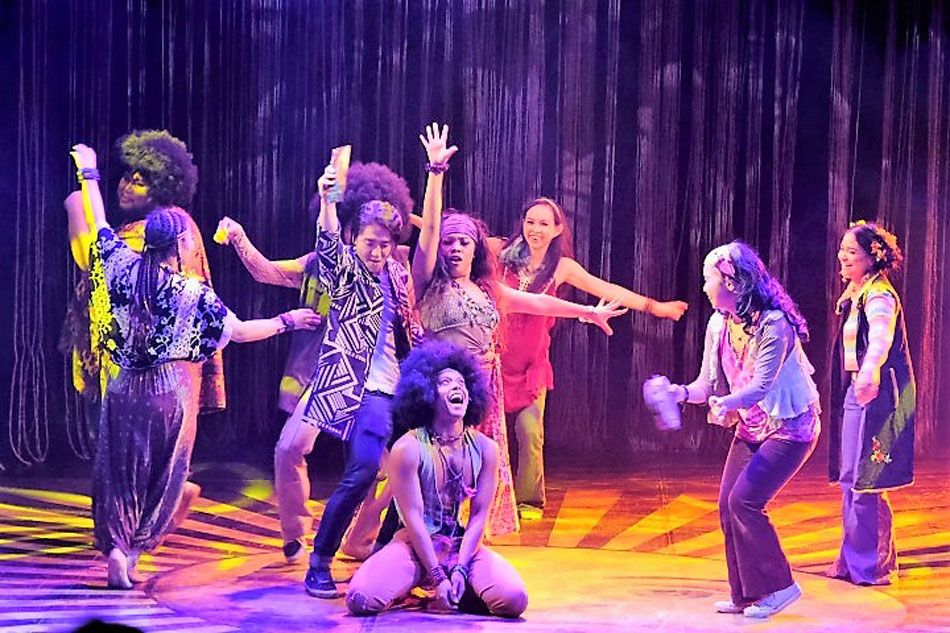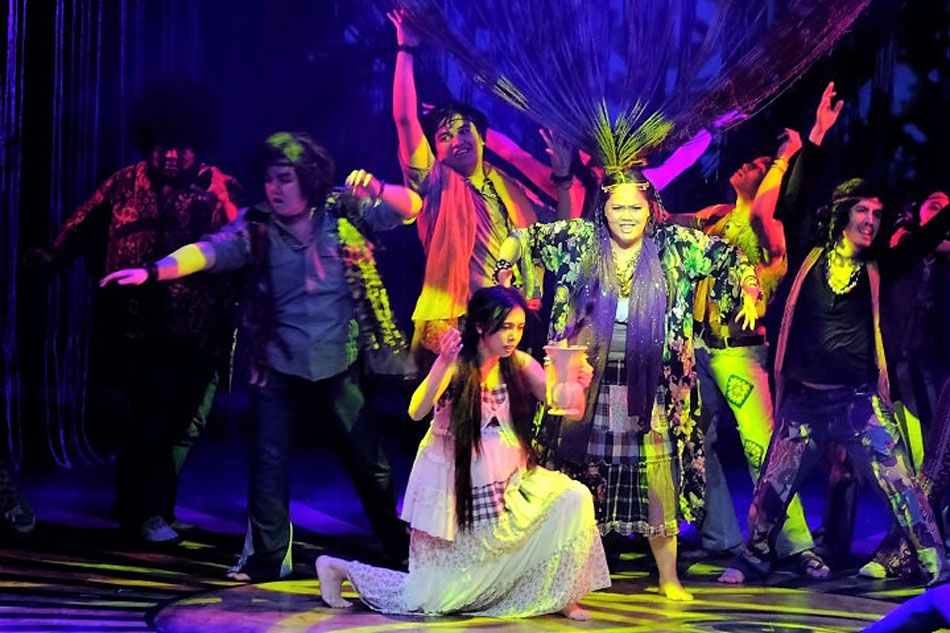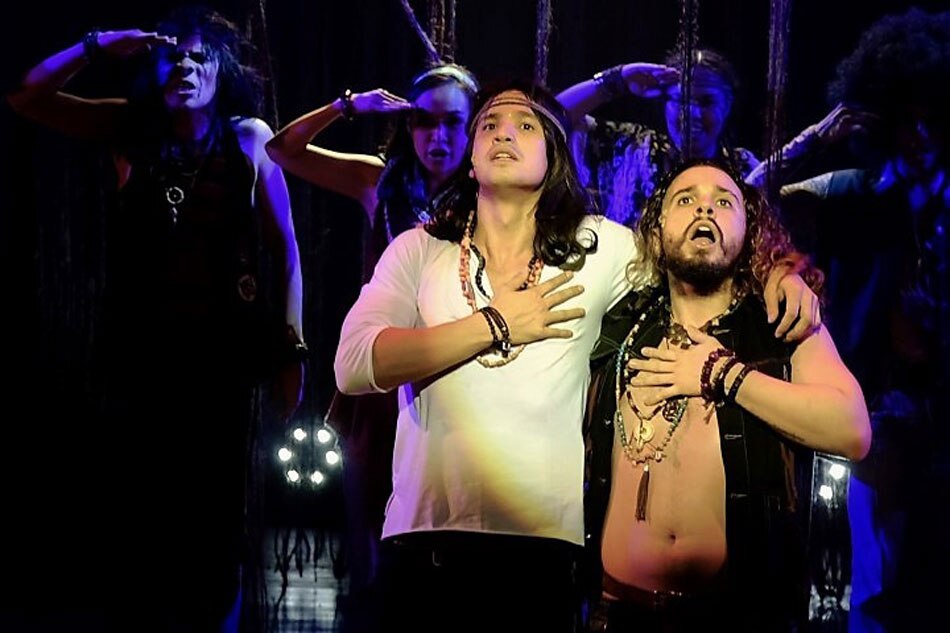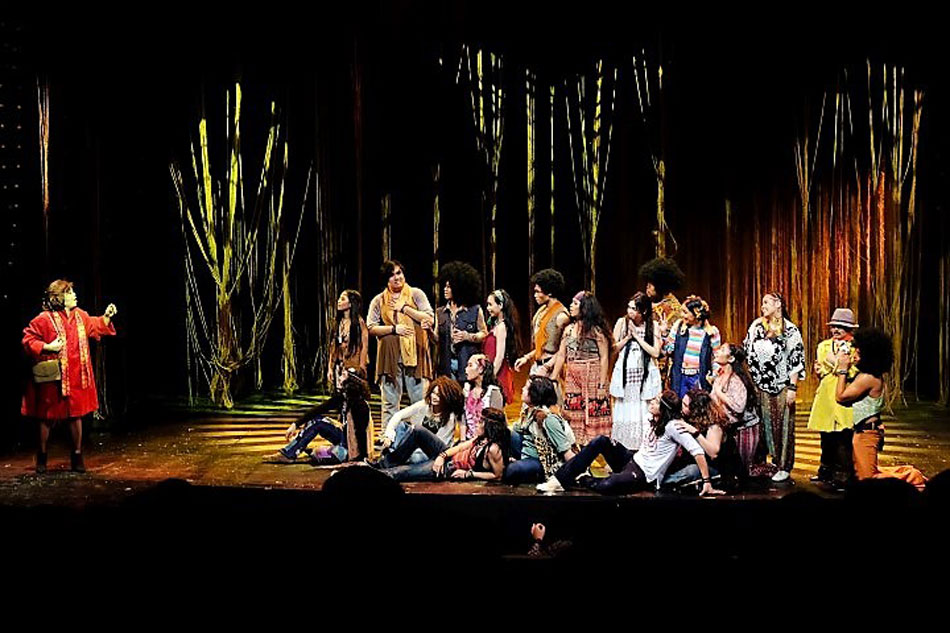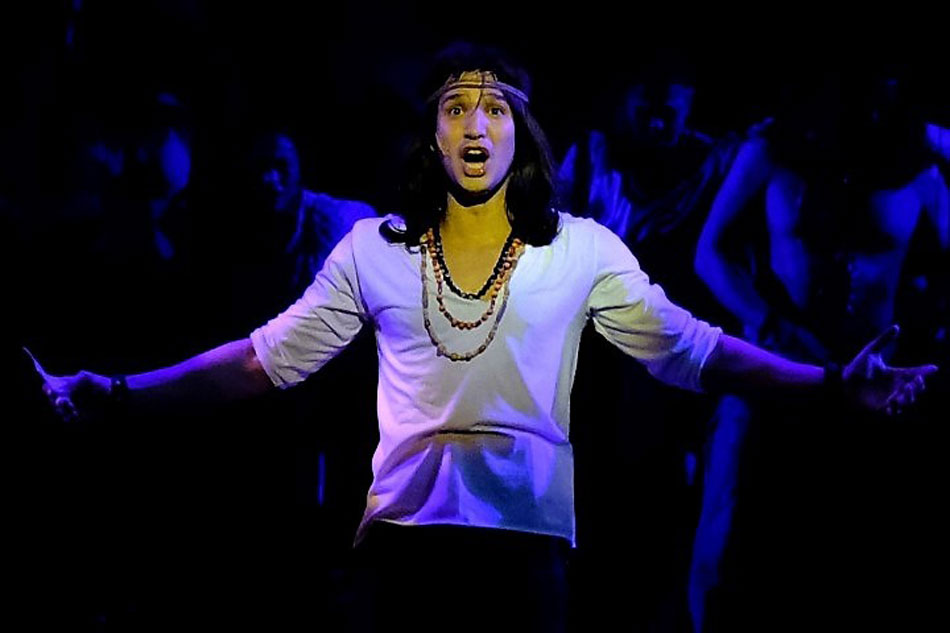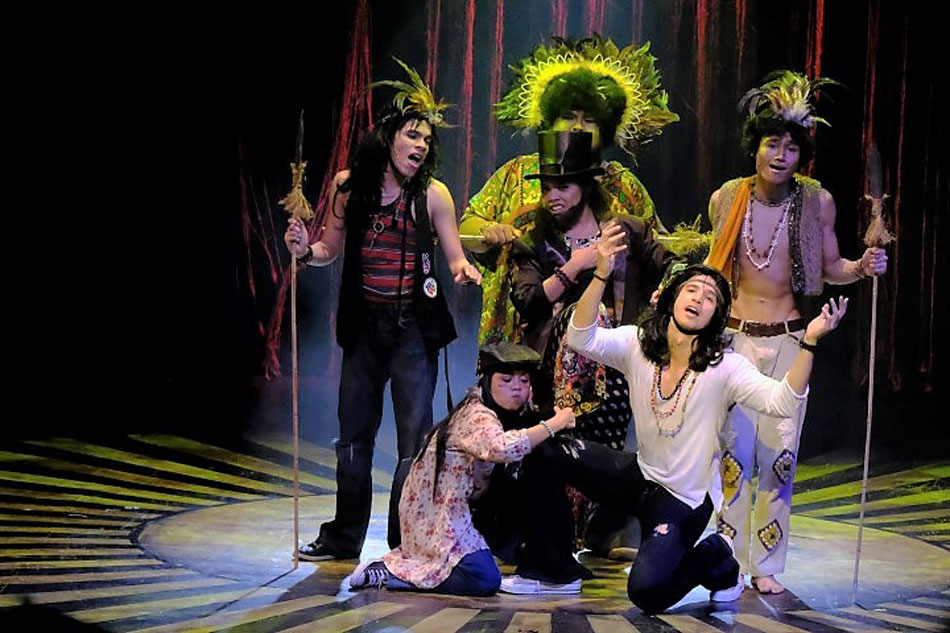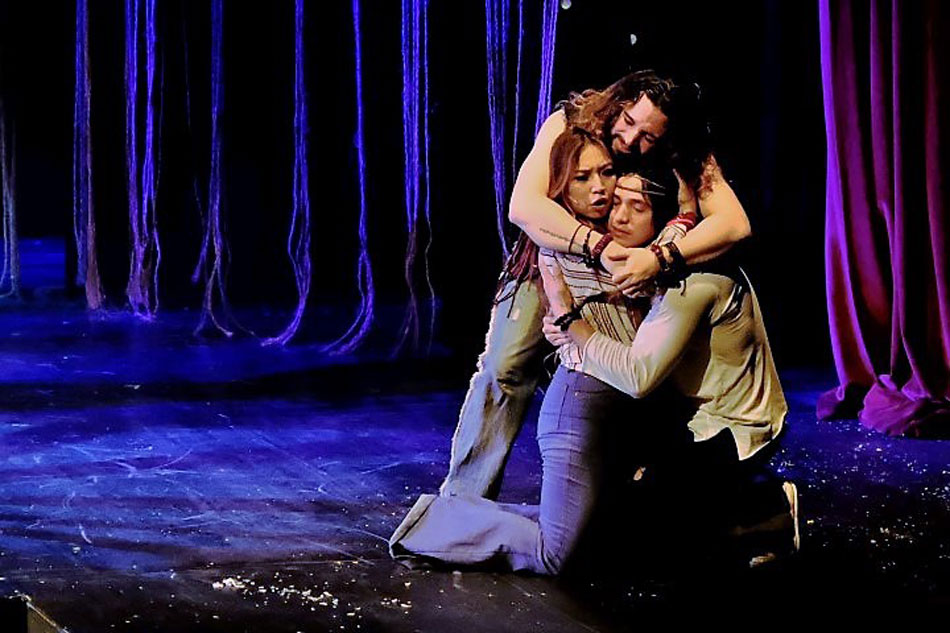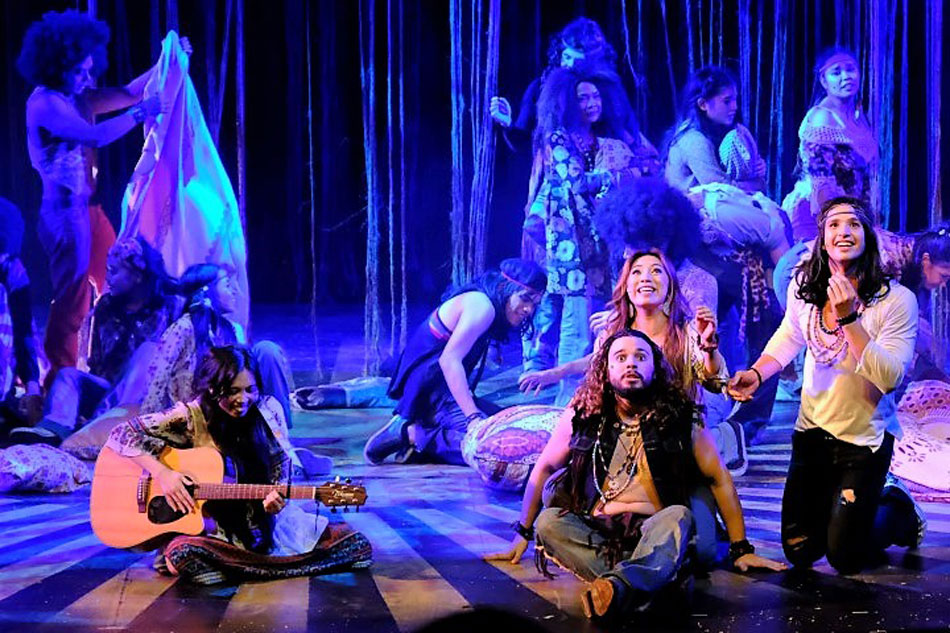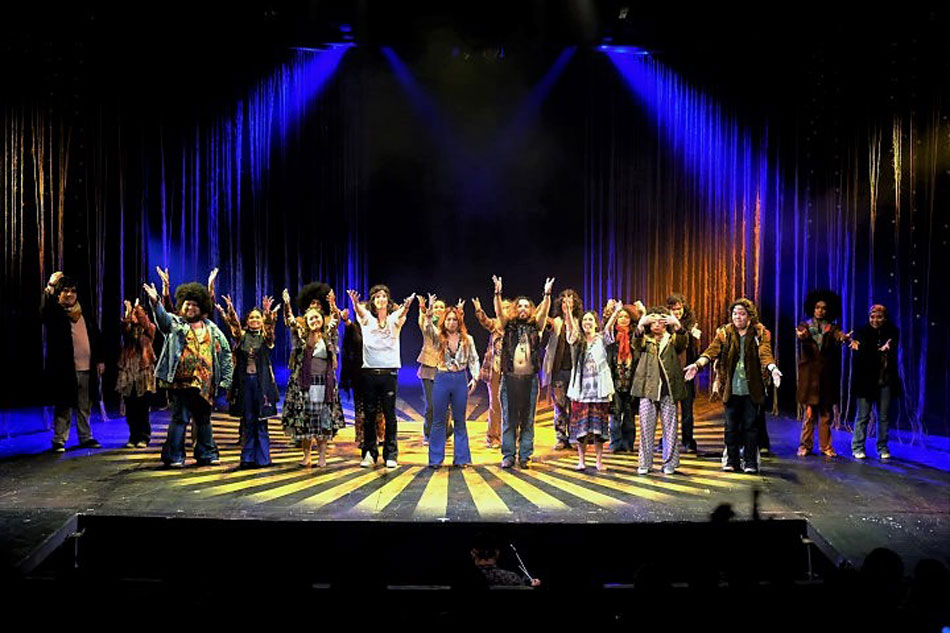Theater review: Hallucinating hippies of 'Hair' | ABS-CBN
ADVERTISEMENT

Welcome, Kapamilya! We use cookies to improve your browsing experience. Continuing to use this site means you agree to our use of cookies. Tell me more!
Theater review: Hallucinating hippies of 'Hair'
Theater review: Hallucinating hippies of 'Hair'
Fred Hawson
Published Nov 24, 2017 01:08 PM PHT
MANILA -- For its final show on its 50th anniversary, Repertory Philippines chose to stage a Broadway play that is also celebrating its 50th anniversary this year -- "Hair."
MANILA -- For its final show on its 50th anniversary, Repertory Philippines chose to stage a Broadway play that is also celebrating its 50th anniversary this year -- "Hair."
This musical has music by Galt MacDermot, with book and lyrics by James Rado and Gerome Ragni. It began off-Broadway in 1967, and eventually went on Broadway the following year. Its original soundtrack generated a couple of popular hit singles. Because of these songs, I knew this musical was about hippie culture, but this is the first I was going to see the songs in the context of the show from which they came.
This musical has music by Galt MacDermot, with book and lyrics by James Rado and Gerome Ragni. It began off-Broadway in 1967, and eventually went on Broadway the following year. Its original soundtrack generated a couple of popular hit singles. Because of these songs, I knew this musical was about hippie culture, but this is the first I was going to see the songs in the context of the show from which they came.
It was the late 1960s in New York City, a tribe of hippies, led by their charismatic main man George Berger, welcomed a naive farm boy Claude Bukowski into their fold. Claude was initiated into their world of drug use and free love. During one of their anti-Vietnam War protests, the other hippies burned their draft cards. Claude initially also threw his card into the fire, but decided to pick it back out, thinking of accepting the draft and going to serve his country as a soldier.
It was the late 1960s in New York City, a tribe of hippies, led by their charismatic main man George Berger, welcomed a naive farm boy Claude Bukowski into their fold. Claude was initiated into their world of drug use and free love. During one of their anti-Vietnam War protests, the other hippies burned their draft cards. Claude initially also threw his card into the fire, but decided to pick it back out, thinking of accepting the draft and going to serve his country as a soldier.
The stage was bare except for layers of see-through curtains of hanging rope as the backdrop. The cast would later bring in blankets and pillows for them to lounge around in as the scene required. The magic of the minimalist stage design by Joey González-Mendoza was completed by the remarkably dynamic lighting design by John Batalla, one of the best lighting work I've seen this year. Musical director Ejay Yatco himself was also dressed in hippie duds as he was conducting the live band in the pit.
The stage was bare except for layers of see-through curtains of hanging rope as the backdrop. The cast would later bring in blankets and pillows for them to lounge around in as the scene required. The magic of the minimalist stage design by Joey González-Mendoza was completed by the remarkably dynamic lighting design by John Batalla, one of the best lighting work I've seen this year. Musical director Ejay Yatco himself was also dressed in hippie duds as he was conducting the live band in the pit.
ADVERTISEMENT
The hippies in their colorful costumes and wild wigs entered to dance and move on the stage, moaning and writhing a lot in some sort of hypnotic initiation rite. Then Moira Lozada stepped out to lead the tribe to sing the show's most famous song "Aquarius" in all its psychedelic glory to begin the show on a high note.
The hippies in their colorful costumes and wild wigs entered to dance and move on the stage, moaning and writhing a lot in some sort of hypnotic initiation rite. Then Moira Lozada stepped out to lead the tribe to sing the show's most famous song "Aquarius" in all its psychedelic glory to begin the show on a high note.
After that rousing start, I sort of got lost with most of Act 1 with its various episodes of hippies singing their commentary on drugs, sex and race, dated by the use of some unfamiliar slang lingo and liberal doses of profanity. The singing prowess of the Filipino actors, however, was undeniable in solos like Crissy's "Frank Mills" (by Cara Barredo), Sheila's "Easy to be Hard" (by Caisa Borromeo) and Claude's "Where Do I Go" (by Topper Fabegas), and group songs like "Ain't Got No" and "Hair." Act 1 ended with the same bold ending which made the original show very controversial back in 1967 -- an ending which still made some audience members last night gasp in audible surprise.
After that rousing start, I sort of got lost with most of Act 1 with its various episodes of hippies singing their commentary on drugs, sex and race, dated by the use of some unfamiliar slang lingo and liberal doses of profanity. The singing prowess of the Filipino actors, however, was undeniable in solos like Crissy's "Frank Mills" (by Cara Barredo), Sheila's "Easy to be Hard" (by Caisa Borromeo) and Claude's "Where Do I Go" (by Topper Fabegas), and group songs like "Ain't Got No" and "Hair." Act 1 ended with the same bold ending which made the original show very controversial back in 1967 -- an ending which still made some audience members last night gasp in audible surprise.
In Act 2, the trippy song "Walking in Space" led us into Claude's bizarre red-lit hallucinations about the terrors of war. PJ Rebullida's amazing choreographic execution of that recurring sequence of various wars and deaths made me feel like I was on that same vivid LSD trip as Claude. Songs like "Three-Five-Zero-Zero" and "What a Piece of Work is Man" give a haunting impact. The simple folksy "Good Morning Starshine" then segued to a powerful and catchy finale number "Let the Sun Shine In" which will stick with you long after you've left the theater.
In Act 2, the trippy song "Walking in Space" led us into Claude's bizarre red-lit hallucinations about the terrors of war. PJ Rebullida's amazing choreographic execution of that recurring sequence of various wars and deaths made me feel like I was on that same vivid LSD trip as Claude. Songs like "Three-Five-Zero-Zero" and "What a Piece of Work is Man" give a haunting impact. The simple folksy "Good Morning Starshine" then segued to a powerful and catchy finale number "Let the Sun Shine In" which will stick with you long after you've left the theater.
Fabregas successfully projected Claude's naivete and idealism (Markki Stroem alternates in this role). You can easily pick out Borromeo from the rest of the female cast because of her radiant stage presence and soaring voice. I had never seen George Schulze as manic on stage before as he was last night, riding completely on Berger's outrageous groove.
Fabregas successfully projected Claude's naivete and idealism (Markki Stroem alternates in this role). You can easily pick out Borromeo from the rest of the female cast because of her radiant stage presence and soaring voice. I had never seen George Schulze as manic on stage before as he was last night, riding completely on Berger's outrageous groove.
Barredo was innocently sweet as Crissy as Maronne Cruz was wacky weird as Jeanie. Big guy Alfritz Blanche stood out from the ensemble as Hud, with his big afro and big voice in short featured solos in the group songs. Franco Ramos (as Woof) and Jay Barrameda (as Margaret Mead) also gave notable solos.
Barredo was innocently sweet as Crissy as Maronne Cruz was wacky weird as Jeanie. Big guy Alfritz Blanche stood out from the ensemble as Hud, with his big afro and big voice in short featured solos in the group songs. Franco Ramos (as Woof) and Jay Barrameda (as Margaret Mead) also gave notable solos.
It was a tough challenge for director Chris Millado to make this 50-year old play current again for the new generation. I found it difficult to connect with Act 1 as it set the flower-power mood of the late 1960s in episodic introductory sketches with some now-obscure dated references.
It was a tough challenge for director Chris Millado to make this 50-year old play current again for the new generation. I found it difficult to connect with Act 1 as it set the flower-power mood of the late 1960s in episodic introductory sketches with some now-obscure dated references.
Fortunately, Act 2 completely turned things around for me. Act 2 gives "Hair" its timeless appeal and makes this show absolutely worth watching. Everything came together solidly and strongly in terms of its still potent anti-war message and the incredible ensemble performance by the whole cast.
Fortunately, Act 2 completely turned things around for me. Act 2 gives "Hair" its timeless appeal and makes this show absolutely worth watching. Everything came together solidly and strongly in terms of its still potent anti-war message and the incredible ensemble performance by the whole cast.
"Hair" runs at the Onstage Greenbelt 1 until December 17.
"Hair" runs at the Onstage Greenbelt 1 until December 17.
This review was originally published in the author's blog, "Fred Said."
This review was originally published in the author's blog, "Fred Said."
ADVERTISEMENT
ADVERTISEMENT


